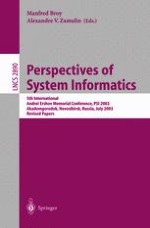2003 | Buch
Perspectives of System Informatics
5th International Andrei Ershov Memorial Conference, PSI 2003, Akademgorodok, Novosibirsk, Russia, July 9-12, 2003. Revised Papers
herausgegeben von: Manfred Broy, Alexandre V. Zamulin
Verlag: Springer Berlin Heidelberg
Buchreihe : Lecture Notes in Computer Science
Enthalten in: Professional Book Archive
